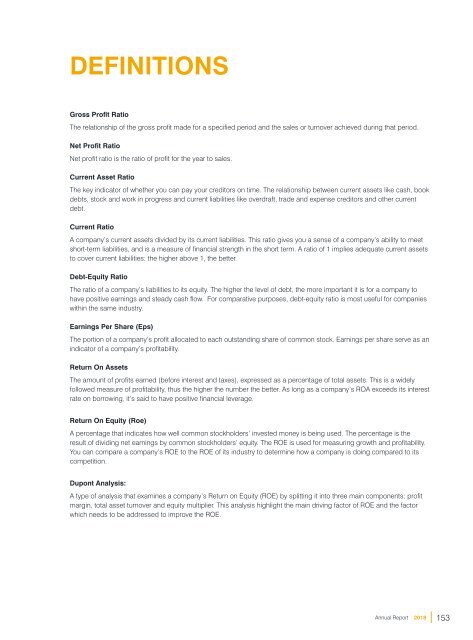MS AR 2018 (1)
Create successful ePaper yourself
Turn your PDF publications into a flip-book with our unique Google optimized e-Paper software.
DEFINITIONS<br />
Gross Profit Ratio<br />
The relationship of the gross profit made for a specified period and the sales or turnover achieved during that period.<br />
Net Profit Ratio<br />
Net profit ratio is the ratio of profit for the year to sales.<br />
Current Asset Ratio<br />
The key indicator of whether you can pay your creditors on time. The relationship between current assets like cash, book<br />
debts, stock and work in progress and current liabilities like overdraft, trade and expense creditors and other current<br />
debt.<br />
Current Ratio<br />
A company’s current assets divided by its current liabilities. This ratio gives you a sense of a company’s ability to meet<br />
short-term liabilities, and is a measure of financial strength in the short term. A ratio of 1 implies adequate current assets<br />
to cover current liabilities: the higher above 1, the better.<br />
Debt-Equity Ratio<br />
The ratio of a company’s liabilities to its equity. The higher the level of debt, the more important it is for a company to<br />
have positive earnings and steady cash flow. For comparative purposes, debt-equity ratio is most useful for companies<br />
within the same industry.<br />
Earnings Per Share (Eps)<br />
The portion of a company’s profit allocated to each outstanding share of common stock. Earnings per share serve as an<br />
indicator of a company’s profitability.<br />
Return On Assets<br />
The amount of profits earned (before interest and taxes), expressed as a percentage of total assets. This is a widely<br />
followed measure of profitability, thus the higher the number the better. As long as a company’s ROA exceeds its interest<br />
rate on borrowing, it’s said to have positive financial leverage.<br />
Return On Equity (Roe)<br />
A percentage that indicates how well common stockholders’ invested money is being used. The percentage is the<br />
result of dividing net earnings by common stockholders’ equity. The ROE is used for measuring growth and profitability.<br />
You can compare a company’s ROE to the ROE of its industry to determine how a company is doing compared to its<br />
competition.<br />
Dupont Analysis:<br />
A type of analysis that examines a company’s Return on Equity (ROE) by splitting it into three main components; profit<br />
margin, total asset turnover and equity multiplier. This analysis highlight the main driving factor of ROE and the factor<br />
which needs to be addressed to improve the ROE.<br />
Annual Report <strong>2018</strong><br />
153


